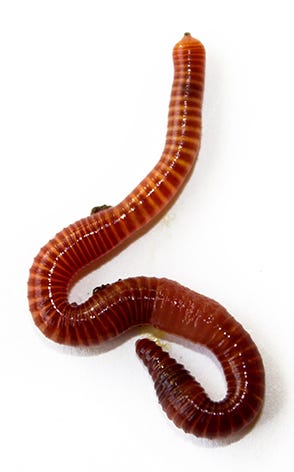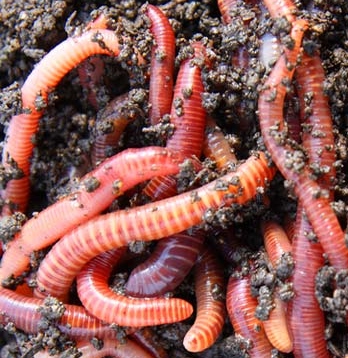Red worms: The best choice for composting
Red worms: The best choice for composting
Blog Article
Transform Your Garden With Red Wigglers: Idea
By establishing a fundamental worm container and comprehending the dietary demands of these amazing animals, garden enthusiasts can dramatically improve soil quality and plant wellness. The process of converting natural waste into abundant, abundant castings is both simple and fulfilling.

Benefits of Red Wigglers
Red wigglers, medically referred to as Eisenia fetida, are typically hailed as nature's composting champs. These exceptional worms serve several vital benefits that can significantly boost yard health and performance. They are efficient decomposers, breaking down natural material such as kitchen area scraps and backyard waste right into nutrient-rich vermicompost (red worms). This all-natural plant food improves the dirt, advertising healthy plant growth and boosting dirt framework.

One more noteworthy benefit of red wigglers is their capacity to decrease waste. By composting natural materials that would otherwise add to land fill waste, they play a crucial function in lasting horticulture techniques. Finally, incorporating these worms right into your gardening regimen can cause raised yields, healthier plants, and an extra vivid garden atmosphere, making them very useful allies for gardeners looking for to boost their eco-friendly impact.
Establishing a Worm Bin
Creating a worm bin is a vital step for any individual aiming to harness the advantages of red wigglers in their gardening efforts. An appropriate worm container can be made from various products, consisting of plastic containers, wood pet crates, or commercially available worm containers. The first consideration is dimension; a bin that goes to least 2 feet wide, 3 feet long, and 1 foot deep is typically optimal for a little to tool variety of worms.
Following, ensure correct water drainage and ventilation. Drill holes in the bottom for excess dampness to leave and in the sides for airflow. It is very important to produce a bed linen layer, using materials such as shredded newspaper, cardboard, or coconut coir to offer a comfortable environment for the worms. The bedding needs to be damp but not soggy, resembling a moist sponge.
Area the bin in an area that keeps a regular temperature, preferably in between 55 ° F and 77 ° F. Avoid straight sunlight or extreme cool, as these problems can harm the worms. Once the container is established up, enable the bedding to choose a few days before introducing the red wigglers, guaranteeing they have a thriving environment in which to grow.
Feeding Your Red Wigglers
As soon as the worm bin is developed and the red wigglers are presented, appropriate feeding comes to be crucial to maintaining a healthy worm population. Red wigglers thrive on a diverse diet regimen, primarily containing cooking area scraps and organic products. Ideal foods include veggie peels, fruit scraps, coffee premises, and crushed eggshells. It is important to prevent feeding them meat, dairy, or oily foods, as these can create unpleasant smells and bring in pests.
When presenting food, chop the scraps right into smaller pieces to facilitate quicker consumption. Additionally, bury the food underneath a layer of bedding material to avoid fruit flies and various other problems. Display the feeding frequency; a general policy is to give food every 1-2 weeks, relying on the number of worms and the quantity of food waste generated.

Collecting Worm Castings
How can you tell when it's time to gather worm castings from your container? The readiness of worm spreadings is indicated by a few crucial indications. Initially, the product in the bin ought to show up dark, crunchy, and rich in appearance, resembling a fine soil. In addition, the initial food scraps should be considerably broken down or almost unrecognizable, indicating that the worms have effectively processed them.
One more sign is the reduction in worm activity; as the spreadings gather, worms tend to move in the direction of fresher food resources. If you notice a decrease in worm movement and the presence of spreadings at the bottom of the container, it's a clear signal that harvesting schedules.
To collect, carefully scoop out the spreadings, making sure to reduce disruption to the worms. A popular method entails dividing the castings making use of light; worms often tend to delve away from the light, enabling you to accumulate the castings more easily.
Gathering consistently, about every 3 to 6 months, makes sure a continuous supply of this nutrient-rich see this here modification for your horticulture ventures. Keep in mind, the high quality of your castings straight affects the health and wellness of your plants.
Using Castings in Your Garden
(eisenia fetida for sale)Using worm spreadings in your yard can significantly improve dirt wellness and plant development - red worms. These nutrient-rich natural fertilizers give essential macro and micronutrients, boosting the total fertility of your soil. By including worm spreadings into your garden beds, you can promote advantageous microbial task, which assists in nutrient accessibility and boosts soil structure
To use worm spreadings successfully, mix them into the leading couple of inches of dirt before growing. This ensures that nutrients are conveniently available to your plants. Additionally, you can create a nutrient-dense fluid plant food by soaking worm castings in water for a week, then applying the resulting "worm tea" straight to your plants. This technique not just offers instant nutrients but also encourages healthy and balanced origin development.
Worm castings also boost dampness retention within the dirt, minimizing the need for regular watering. Their all-natural pH equilibrium makes them appropriate for various plant types, from veggies to ornamentals. Frequently including worm castings right into your gardening regimen can cause durable plant development, increased yields, and a general much healthier yard ecosystem. Embrace the advantages of worm spreadings for a flourishing and sustainable yard.
Verdict
Integrating red wigglers into yard methods provides significant benefits, including boosted dirt fertility and boosted plant health and wellness. By developing a worm container, providing suitable food, and regularly collecting nutrient-rich spreadings, gardeners can cultivate a lasting ecosystem. Making use of worm castings and "worm tea" better adds to moisture retention and nutrient schedule in the dirt. Inevitably, the integration of red wigglers assists in an effective and eco-friendly technique to horticulture, advertising overall ecological equilibrium.
Report this page